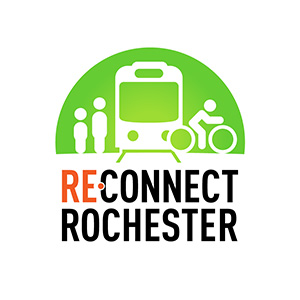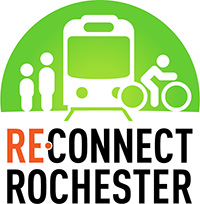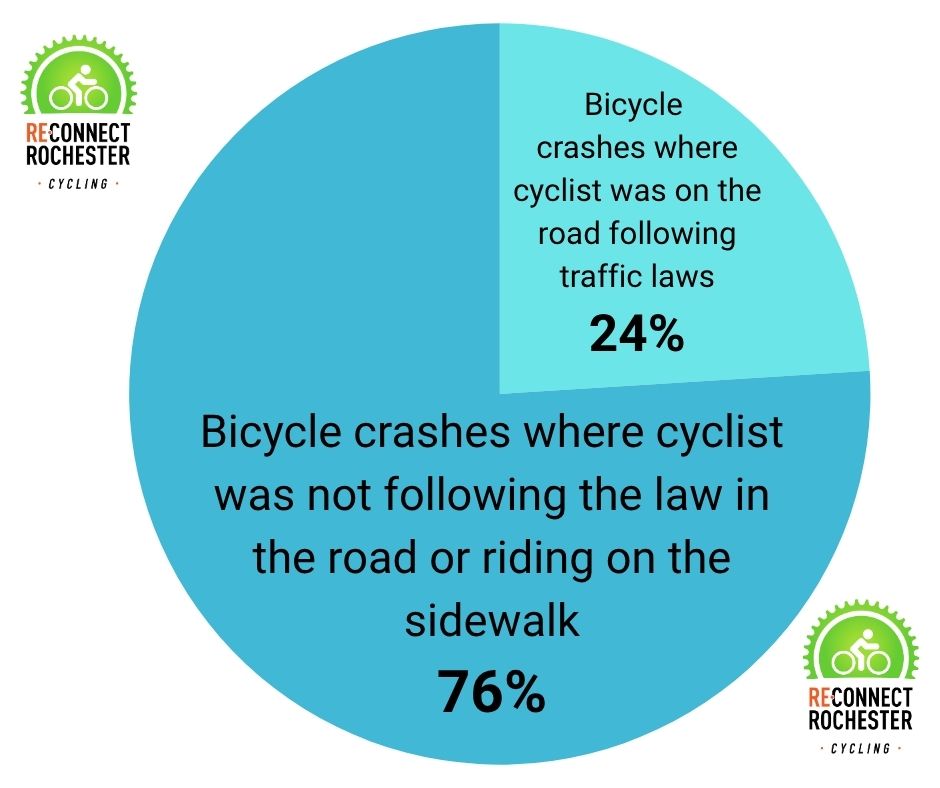By Jesse Peers, Cycling Manager
As promised, we wanted to follow up our March blog examining the most common cyclist crash in Monroe County with further analysis. A huge component of safety is knowing what those common crash scenarios are and what we can do to significantly diminish the likelihood of our involvement in them. Though this article focuses more on road user behavior and errors, know up front that Reconnect Rochester spends most of our time focusing on better street design (engineering!) as the best solution.

Quick note: No blog on bike tips is a substitute for our on-bike Smart Cycling class. (Taking this class is what it took for me to get comfortable riding around back in 2013). The class is small, fun and propels students out with know-how and confidence. Stay tuned for 2026 dates or take the League of American Bicyclists’ online version in the meantime.
Kobe Bryant used to say as he analyzed opponents’ games and habits, “If [something is] predictable, it’s preventable.” In his phenomenal book Killed By A Traffic Engineer, Wes Marshall argues that Kobe’s point also goes for traffic: Some of the errors motorists make are so predictable and, therefore, engineers can adjust road designs accordingly.
Because I know the mistakes Monroe County motorists often make and maintain awareness as I ride, there’s times my well-honed Spider-Sense goes off: “Ooo boy, if there was gonna be a crash, it would be precisely this scenario right here…” I slow down, don’t stress, and make sure everyone around me sees me to ensure my safety. We hope you can do the same. Let’s examine the other common crash scenarios in Monroe County involving bicyclists.
Yes, we know not all bike crashes are reported. Even if the info we receive isn’t everything, we’d still contend that what we receive gives us a pretty good glimpse at what’s transpiring out there. The findings are still instructive.
First off. A major takeaway:
Monroe County motorists make a lot of mistakes interacting with sidewalk riders. Riding in the street, following the rules, is safer than many think.
Most Common CYCLIST Error – running a red light/stop sign or biking through crosswalk during Don’t Walk phase
Reconnect Rochester annually champions the Idaho Stop in New York State. Passage would allow bicyclists to treat stop signs as yield signs and red lights as stop signs. Many intersection signals don’t detect cyclists’ presence and believe it or not, the statistics say the Idaho Stop is safer for cyclists.
BUT:
- It’s not the law right now
- The Idaho Stop is safe only when certain conditions are met, as this Santa Cruz advocate says well:
What can cyclists do?
Proceed through an intersection when it’s clear & you know you’re being yielded to. Don’t run red lights or stop signs. Don’t roll through a crosswalk during the Don’t Walk phase. Report traffic signals that don’t detect your presence to Monroe County DOT.
What can motorists do?
Stay alert. Make sure the way is clear in each direction before proceeding. Yield to anyone in the crosswalk.
2nd Most Common MOTORIST Error – turns into cyclists going straight
Note: The Most Common MOTORIST Error was covered in our March blog post
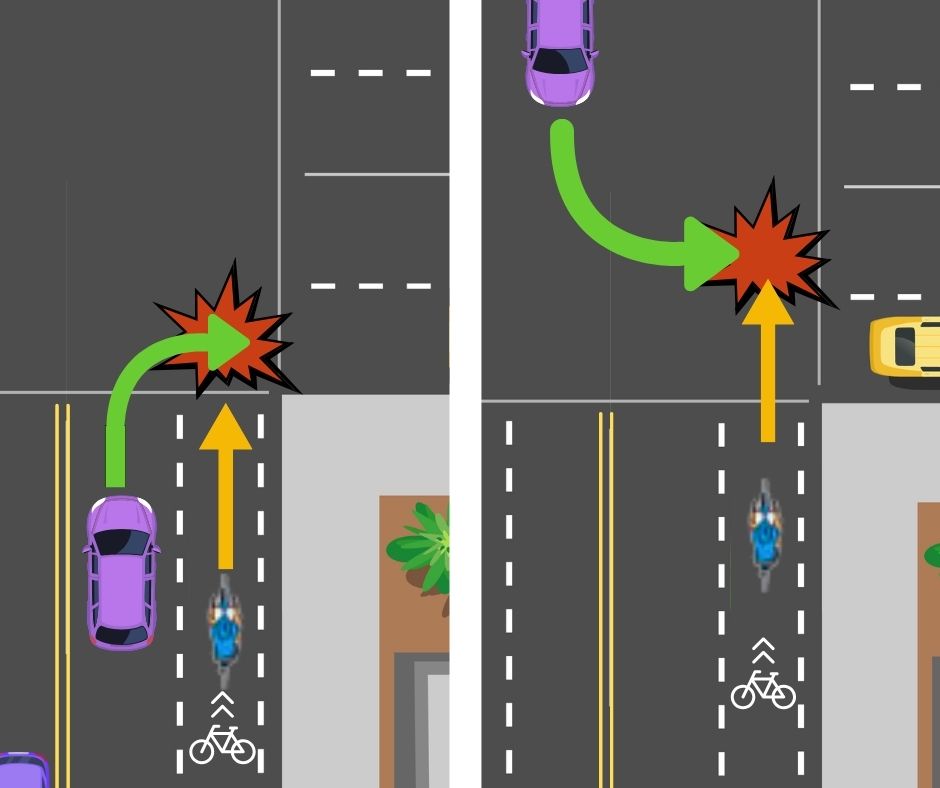
You know Reconnect Rochester: we love bike lanes! The more physical protection and separation from motor vehicle traffic, the better. Bike lanes, without protected intersections however, still present a potential conflict point at intersections. Sometimes motorists coming up behind the cyclist make a right turn into them as the cyclist is proceeding straight. This is called a right hook. Other times, motorists coming from the opposite direction will take a left turn into the straightgoing cyclist. This is known as a left cross.
In both instances, motorists are required by law to yield to that straight traffic and can’t make the turn unless it can be made with safety. We’ll note that illegal motorist turns are more common with sidewalk riders than classic left crosses and right hooks with cyclists in the roadway.
What can cyclists do?
Approaching intersections, come out from the curb (when it’s clear and safe) to be more visible and to limit motorist’s most dangerous choices. “Taking/Controlling the Lane” can sometimes be the wisest thing to do. It’s also prudent to not barrel through intersections at top speed. Proceed with caution until you know the way is clear and you’re being yielded to.
I’m not a big John Forester fan, but I like this line from his book: “When you approach a red light on a bike-laned street, be especially considerate to move out of the bike lane to maintain sufficient room on your right for cars to turn right on red. That is both politeness on your part and self-preservation…”

What can motorists do?
Yield to straight going cyclists before turning right or left. As prescribed in the image above, make right turns close to the curb, yielding to traffic already in the bike lane or shoulder.
2nd Most Common CYCLIST Error – wrong way riding
When cyclists ride in the street, they’re required by law to ride on the right side of the road with the flow of traffic. As I’m sure you’ve seen, a lot of bicyclists here choose to ride on the left side against the flow of traffic. At first glance, it’s easy to see why: They’d much rather see traffic come at them than not see traffic coming behind them. However, it’s a ticketable offense and we’ve got the data to prove it’s one of the leading causes of crashes here. The laws of physics make this crash especially severe on the cyclist: If you’re biking on the left at 10mph and are hit head on by a car in the opposite direction going 30mph, that’s literally the equivalent of getting hit at 40mph.
You’re not walking away from that crash.
Image taken from NYBC’s Pocket Guide, available as a free PDF here
What can cyclists do?
Ride on the right side of the road with the flow of traffic. This takes getting used to, but you’re more safe, visible and predictable this way. To make it easier, stick to the lines on our ROC Easy Bike map.
What can motorists do?
Look both ways at intersections, driveways and parking lot exits and ensure the way is clear before turning. Stay alert.
3rd Most Common MOTORIST Error – unsafe passing
Every bicyclist’s greatest fear – riding on the right side of the road, doing everything you’re supposed to do, and getting hit from behind by a straightgoing motorist – is not that common; the other crash scenarios we’ve discussed here are much more common.
But getting hit from behind does happen. Chances are higher on arterials when there are no bike lanes present. Getting hit from behind by a straightgoing motorist while in a bike lane is quite rare.
We find it interesting that much of the time when a cyclist does get hit from behind, it either happens at night or in the suburbs. Dedicated bike infrastructure and street lighting are less prevalent outside the City. Speeds are higher there and sometimes there’s not even a shoulder to ride in. The more “road diets” County DOT and NYSDOT can do, the safer suburban cyclists will be.
What can cyclists do?
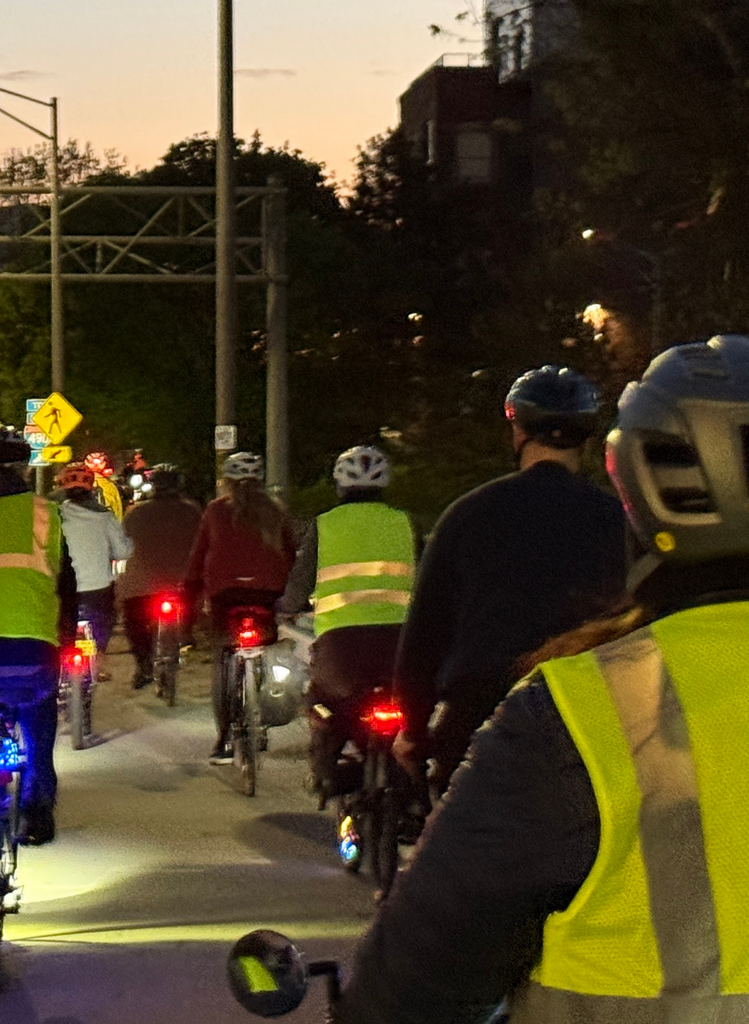
If riding at night, it’s the law for bicyclists to have a red light in the rear and a white light in the front (reflectors don’t suffice). Of course for their benefit, the cyclist can go beyond satisfying the law to wearing bright reflective material that makes them even more visible. Two stage left turns and riding along the easy bike network make this crash less likely. Advocate for protected bike infrastructure.
What can motorists do?
Slow down and maintain vigilance while driving. It’s New York State law to pass cyclists at a safe distance. In Monroe County, that safe passing distance is at least 3 feet.
3rd Most Common CYCLIST Error – failing to yield to cross traffic
When any vehicle operator comes out of a driveway/parking lot or comes to the end of a minor residential street up to a major street, they must stop (before entering the sidewalk/crosswalk area) whether there is a stop sign or not. They can only proceed straight across or turn onto that busier road when the way is clear and they can proceed with safety. A significant factor in crashes in Rochester is cyclists (and motorists, too, for that matter) coming to the end of a residential side street and proceeding across a major road without yielding to that cross traffic (which has the right of way) and waiting until the way is clear.
Granted, sometimes that cross traffic is busy and/or that cross traffic can be speeding. But they have the right of way. If it’s rush hour, it might be a good idea for the cyclist to head to the nearest signalized intersection via the sidewalk and press the “beg button” to help them cross or turn.
Of course, lower speed limits, speed/red light cameras, traffic calming and more crosswalks would make this crash less common and make it easier to get around by bike.
What can cyclists do?
Don’t cross until the way is clear. If traffic is busy, head to the nearest signalized intersection via the sidewalk and press the “beg button” to help you cross or turn.
What can motorists do?
Slow down. Stay alert.
In sum, when cyclists eliminate these common cyclist mistakes from their repertoire and ride in a way that significantly deters the common mistakes motorists make, their safety skyrockets! Consider taking our bike class in 2026 and get acquainted with our ROC Easy Bike map.
Do us a favor and spread this finding widely. If Monroe County could eliminate or lessen this crash scenario, we’d see a significant decrease in motorist/cyclist crashes.
